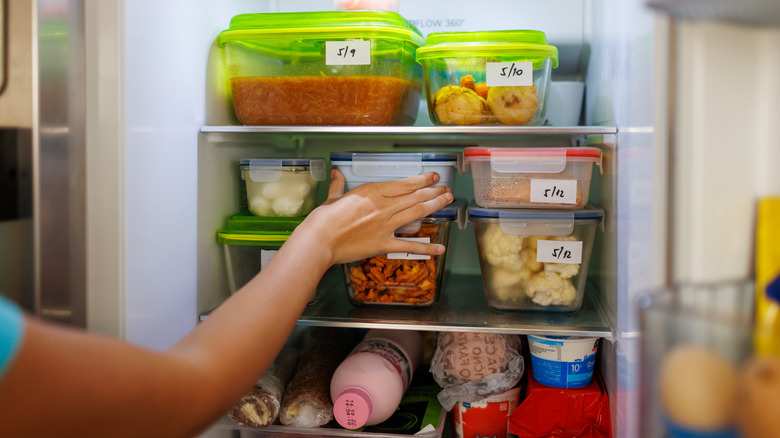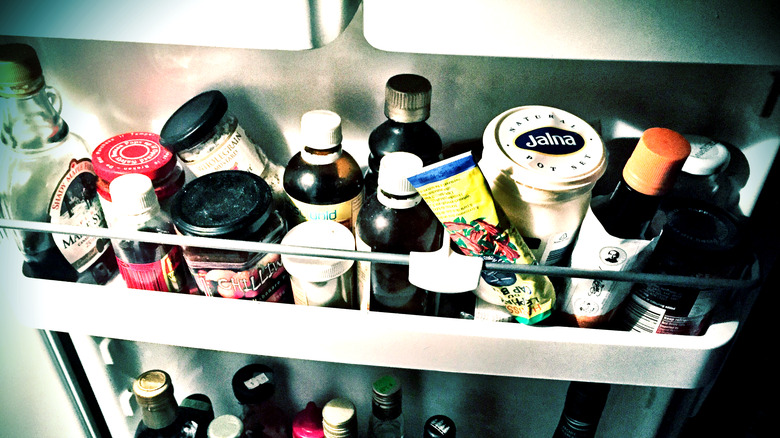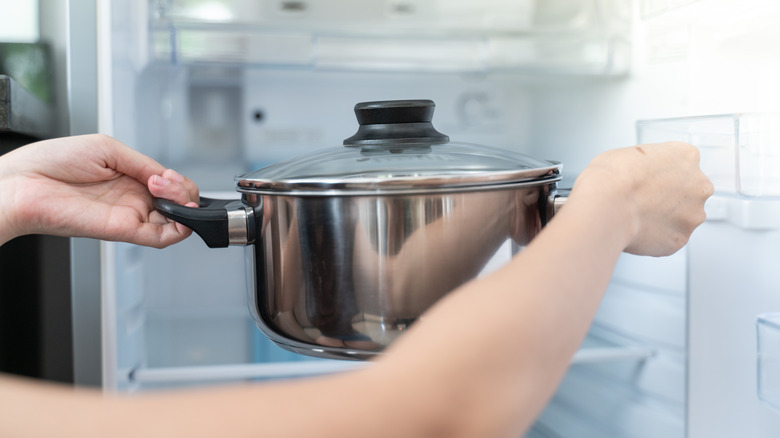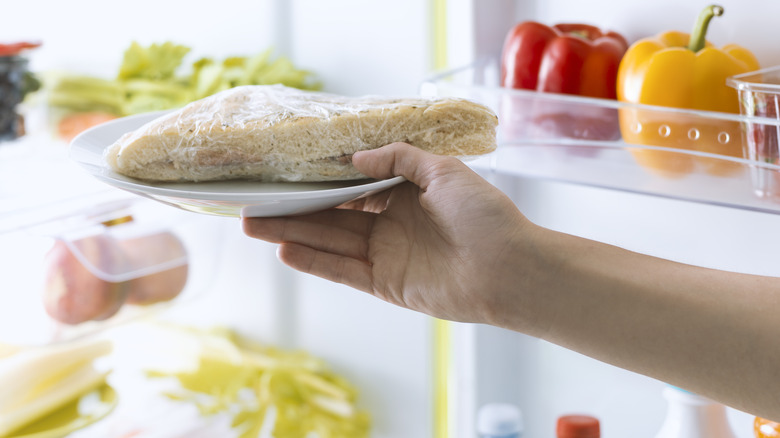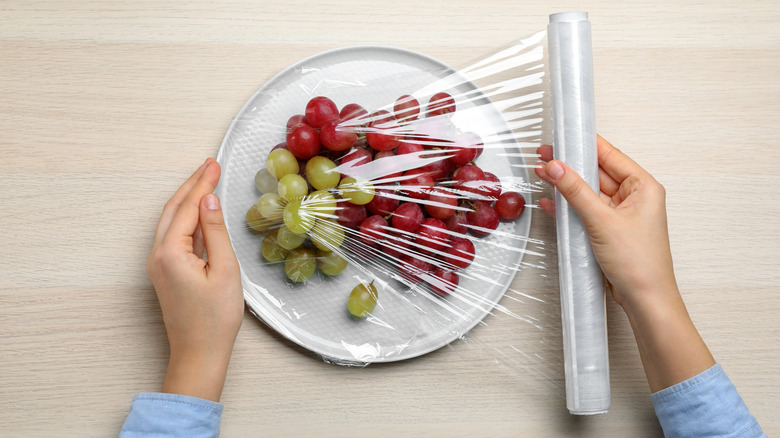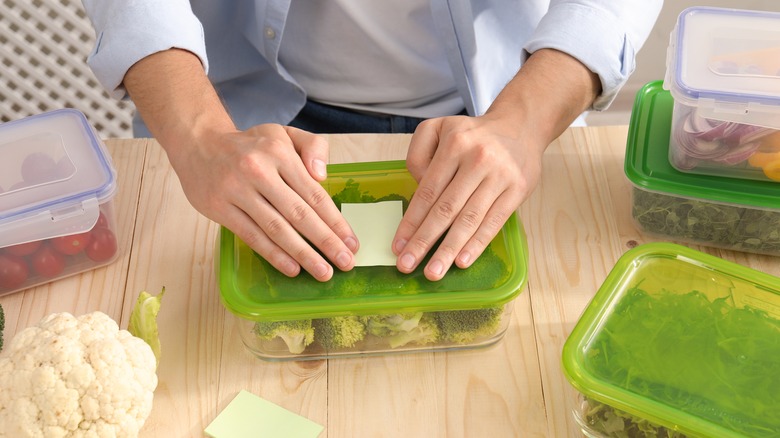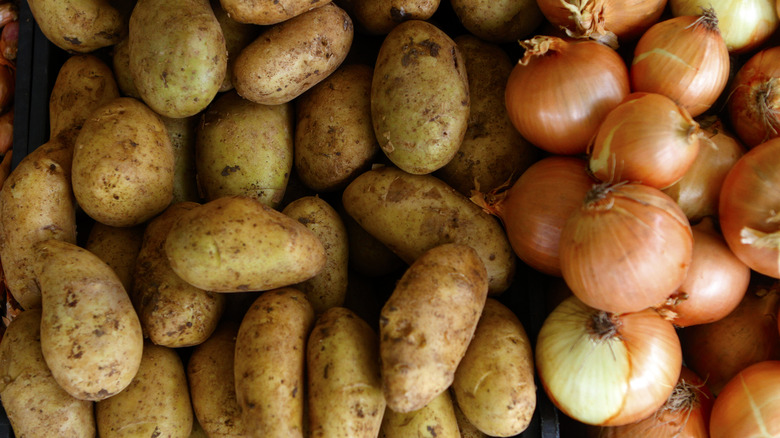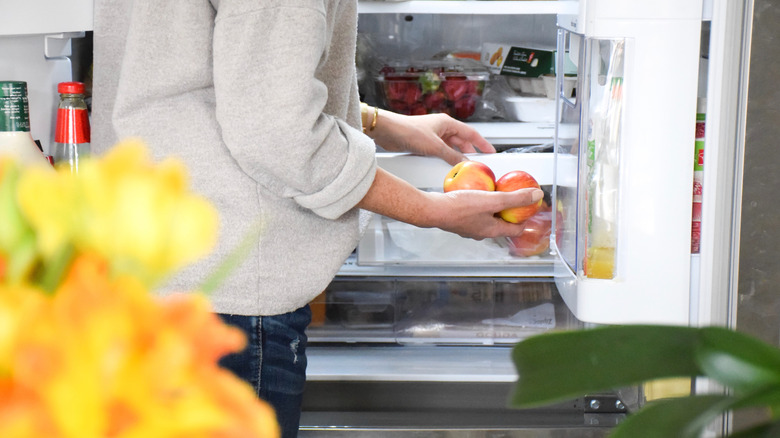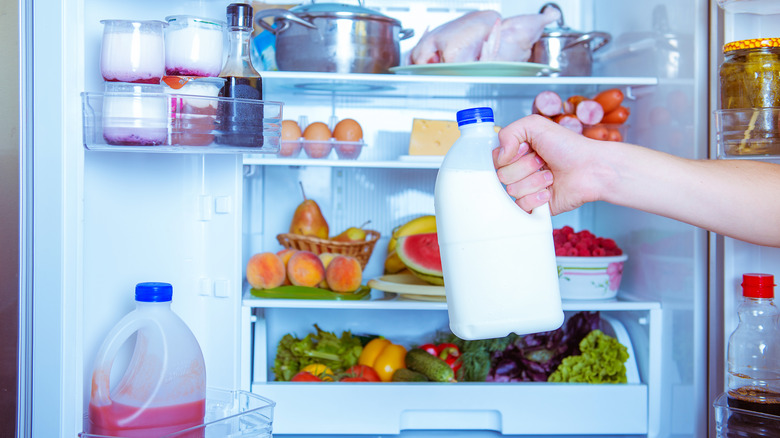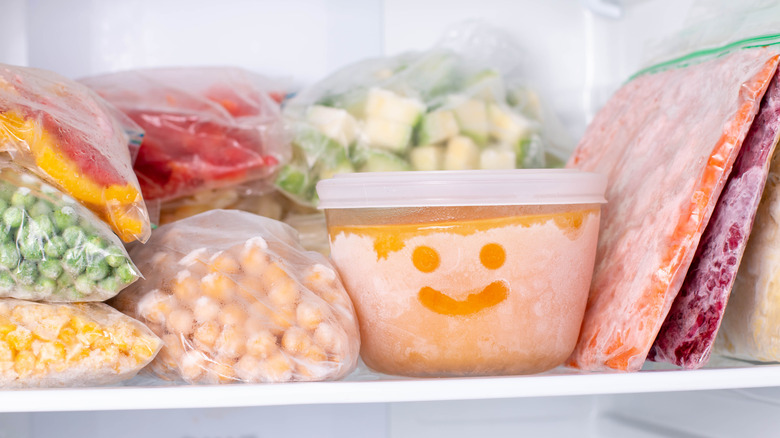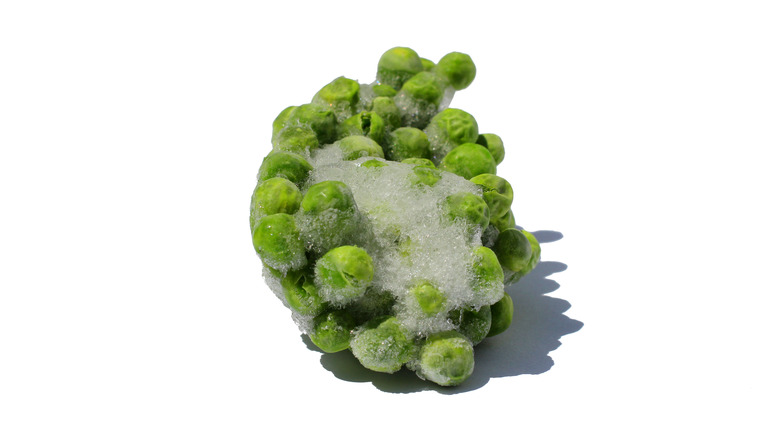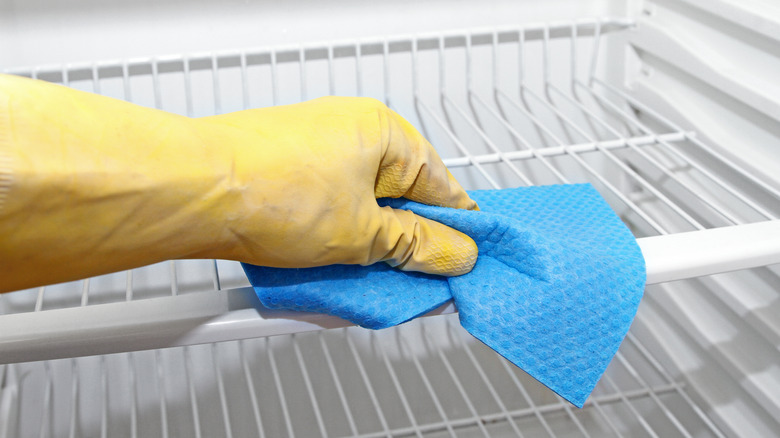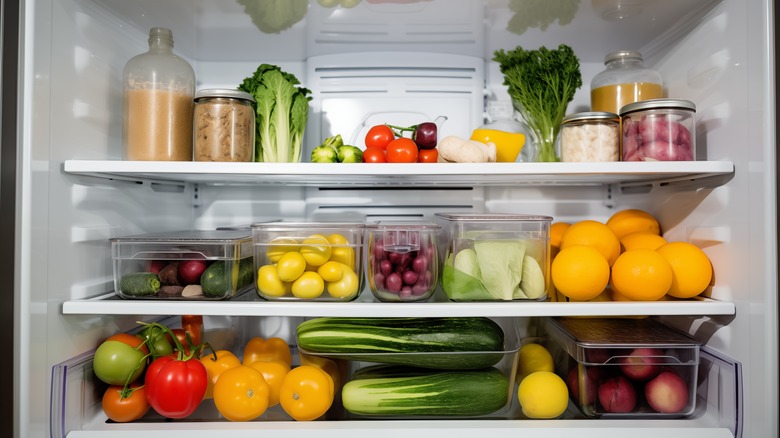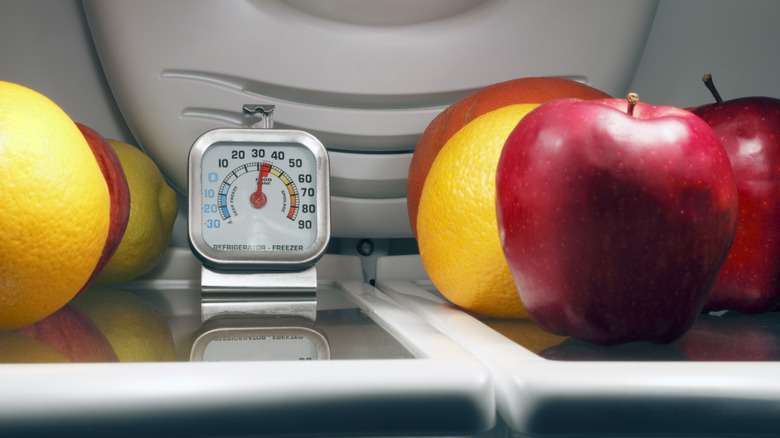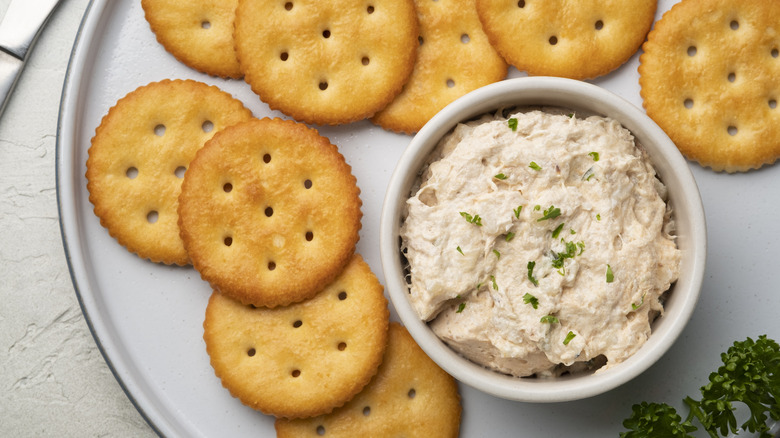Avoid Making These 14 Food Storage Mistakes
It's easy to get inspired when you go grocery shopping. Aisles full of bright colors and pretty pictures make you want to buy food with the best of intentions, but often our eyes are bigger than our stomachs and we end up tossing a significant portion of our grocery haul. In fact, consumers in the United States waste about 92 billion pounds of food each year and about 38% of all food purchase ends up in the trash.
These sad statistics aren't just bad for the environment, they're bad for your finances. Whether you're somebody who cooks most of your meals at home or you're devoted to delivery, there are plenty of easy food storage pitfalls that could be costing you time, money, and (most importantly) flavor. The good news is that there are plenty of easy habits you can implement to optimize food storage that will save you time and money.
1. Overpacking the refrigerator
It's not attractive to look at an overfilled refrigerator. Food piled on top of food gives a sense of clutter that makes you want to just order takeout instead. But aesthetics are not the most important reason you should avoid overfilling your refrigerator.
Refrigerators are not cheap. And when you pack a fridge to the brim with food, you force this precious kitchen appliance to work much harder than it needs to. This causes the unit to consume more energy and makes the inside components wear down faster, meaning you'll have to replace it sooner. A full fridge also hinders proper air circulation.
When cool air can't reach all of your food, it makes it more susceptible to bacteria, which is what you're trying to avoid by storing your food in the fridge in the first place. So if your fridge is bursting at the seams, it's time to do an audit. Throw out old food you no longer need and organize the food you want to keep properly to save space.
2. Putting a large amount of hot food in the refrigerator
It goes without saying that keeping food cold is the key to making it last longer. But if you've got a massive stock pot full of scalding hot soup, you might want to think twice before you pop the whole thing in the fridge.
Putting hot food in the fridge increases its ambient temperature. If you've got other food in there, especially dairy and meat, you risk bringing its temperature up to a range that makes spoilage more likely. That said, you don't want to leave food out after cooking for longer than two hours because that also increases the risk of food borne illness. One way to get your food to cool faster is by dividing it into smaller units. Soup, for example, can be poured into a few different containers and then stored in the refrigerator once it nears room temperature. Also, remember to cover your hot food to keep the steam or odor of dishes from permeating through your fridge.
3. Storing bread in the refrigerator
It's tempting to want to store bread in the refrigerator. Cool it down to keep mold away and then just pop it in the toaster when you're ready for breakfast, right? Wrong. There's a scientific reason why you shouldn't store bread in the refrigerator.
Starch is the main carbohydrate in bread. When bread is made, these large starch molecules are branched randomly and become a key component in bread's chewy, fresh texture. At low temperatures above freezing, the molecules recrystallize into an orderly structure, and this process is a key component to bread staling. But when you put bread in the freezer, the molecules are locked in place and the bread retains its moisture and chewiness once it's reheated. The second best place to store bread is on your counter in a breadbox at room temperature. This is best when you plan to eat the full loaf quickly, as the bread is more susceptible to mold. But storing bread at room temperature will still keep it from going stale for longer than putting it in the fridge.
4. Not storing different foods according to their needs
It's late, you've spent all evening cooking a gorgeous meal, and you're ready to go to bed. You probably want to just throw all your leftovers in the refrigerator and run off to get your beauty sleep. But if you don't spend a little extra time packing up your food properly, you'll pay the price later on.
There are different food storage containers for every kitchen task, and you'd be wise to pay attention to the storage needs of different foods if you want to maximize their lifespan. If you're storing mushrooms, for instance, you should use an open paper bag with paper towels that can absorb the extra moisture. Citrus fruits are fine to hang out on the counter for a few days. If you want them to last longer, throw them in a bag and then into the fridge. For herbs, wash and dry before wrapping them in a kitchen towel and putting them in the fridge or pop them in a container of water like you would flowers. When it comes to storing food, it pays to know how different foods thrive in different environments.
5. Not labeling and dating foods
You're hungry and you've got a hankering for that leftover salmon you made a few days ago. But which day did you make it again? Was it Thursday lunch? Or Tuesday dinner? The answer to that question could be the difference between a delicious meal and an old, dry, and possibly contaminated meal.
The easiest way to remember when you put something in the fridge is to label and date it. This is standard practice in most restaurant kitchens where there are tons of ingredients to keep track of and chefs need to know when to use a certain food or throw it away. But a home kitchen can be just as confusing. Generally speaking, leftovers can be eaten according to the seven day rule, which stipulates that food needs to be either eaten or tossed seven days after it's prepared as long as it's stored at a temperature below 41 degrees Fahrenheit. The date of preparation counts as the first day, so if you make dinner on Monday and put the leftovers in the fridge, they need to be used by Sunday. Keep in mind, however, that not all sources agree on the one week turn around time. According to the USDA, cooked leftovers should get no more than four days in the fridge. The result of more time ranges, from texturally unpleasant food, to foods loaded with bacteria.
6. Storing onions and potatoes together
Onion and potatoes seem like they would be good friends. Both tubers and alliums are widely used, grow underground, and have a hearty, rustic appearance that also serves the dual purpose of being good for dry storage. And although they taste great together in a breakfast hash, these two dirt-grown produce groups do not belong together in storage.
Potatoes are loaded with moisture. In fact, some tubers are about 80% water, which means that when they're stored in a closed environment, things tend to get very humid. Onions are prone to getting squishy and brown when they're exposed to too much moisture, so you'll drastically shorten their shelf life if you put them in a closed container with potatoes. Onions also release a lot of ethylene, which is a chemical responsible for ripening and maturation in fruits and vegetables. Exposure to ethylene will fast-forward potato spoilage and you'll be left with musty-smelling, mushy, unusable potatoes. These veggies both belong in the pantry, but they should be stored at least a few feet away from one another.
7. Not using the crisper drawer properly
Walk over to the crisper door in your refrigerator and look what's inside. Part of an old loaf of bread? Maybe a block of cheddar cheese and a couple of loose apples? The truth is, most people don't know exactly why a fridge has a crisper drawer in the first place, so they end up just loading it with a hodgepodge of loose food items that don't quite belong anywhere else. For you, that ends today.
A crisper drawer isn't just for extra space, it's designed specifically to keep produce crisp and fresh, hence the name. The drawer has a higher humidity than the rest of the refrigerator, which makes it better suited for certain foods. Many refrigerators allow you to adjust the humidity of the drawer, and if you're lucky enough to have two drawers with this feature, adjust one of them for high humidity and the other for low humidity.
The high humidity drawer is good for leafy greens and vegetables that tend to lose moisture easily. The low humidity drawer has more ventilation, making it better for fruits that produce ethylene gas, a chemical responsible for ripening. The idea is to keep that the gas from lingering so that it doesn't make your fruits go bad prematurely. If you've only got one crisper drawer and you can't adjust the humidity, it's best to use it for your thin-skinned and leafy green veggies.
8. Storing dairy products in the refrigerator door
Make yourself your morning coffee and walk over to the fridge to grab some milk to pour in it. Is the carton of milk in the refrigerator door? If the answer is yes, then this tip is for you. Although milk often fits so perfectly snug inside the narrow shelf in the fridge's door, you shouldn't store it there. Because dairy products spoil easily, storing them requires extra attention. But you don't have to do like the Russians, who, before the invention of the fridge, used to keep milk fresh with frogs.
Before you run to the pet store, there's a simple, more modern solution to making your milk last longer: Stop storing it in the refrigerator door. The optimal temperature for milk storage is about 37 degrees Fahrenheit and although most refrigerators are kept at about this temperature, each part of the fridge is not kept equally cool. Because the door is the closest to the room temperature world outside, it is often slightly warmer than the rest of the fridge. Also, since the refrigerator door is often being opened, the items in it spend more time in contact with room temperature air. This difference can be negligible when it comes to foods with a long shelf life, but dairy product should be stored in the refrigerator's main shelves to keep them as cool as possible.
9. Freezing the wrong food
When it comes to food storage, the freezer is often the gold standard to for extending the life of food for the longest possible time. This is not only true for leftovers like pasta sauce and stew, but for veggies like corn, peas, and carrots. Many frozen fruits like berries and bananas are a fantastic addition to a morning smoothie. But not just anything can be stored in the freezer.
One big category that you should keep out of the freezer is leafy greens. Water expands when it freezes, which causes the cell walls inside lettuce and other leafy greens to rupture, so when they thaw, they immediately go limp. Likewise, the liquid inside an egg will also expand when frozen, causing it to rupture. One hugely popular no-no is keeping coffee in the fridge. Many think this will help it retain freshness — but unless you're vacuum sealing, it actually does just the opposite.
Liquids in cans or bottles are a more obvious freezer faux pas since the liquid will expand and cause the container to break. And starchy cooked meals like pasta and rice will turn soft, amorphous, and unappetizing. So, if you want to freeze food like the professionals, do your homework before you chuck any old thing in the freezer!
10. Freezing food for too long
It's tempting to treat your freezer like a time capsule. Throw some steak in there and maybe you'll use it to make a fancy dinner when your kid goes to college in 10 years and you finally have the time. A freezer keeps food technically edible almost indefinitely, leaving food in the freezer for too long diminishes its deliciousness.
Not all food are frozen equally. Uncooked poultry, for example, will retain its quality for almost a year, so if you're reasonably sure you'll cook that chicken in the near-ish future, then go ahead and store it in the freezer. Ham and bacon, on the other hand, will start to taste funky after only about a month or two because the high fat content means things go rancid more quickly. Another big issue is freezer burn, which will sap your food of its internal moisture and leave you with a sub-par dining experience. To avoid this, be sure to seal your food well before it goes in the freezer. Zipped bags removed of air are good, but a home vacuum sealer is the premier tool for food preservation. While you can still eat frozen food safely even after it's been in the freezer for ages, you may not want to.
11. Not cleaning the refrigerator regularly
Cleaning the refrigerator is hardly anyone's favorite task. Liquids congeal easily in low temperatures and digging into the depths of a fridge is like a journey back through your personal culinary timeline. It isn't always pleasant. Keeping your fridge squeaky clean is about more than just the visual allure of sparkling shelves and spotless crisper drawers. A clean refrigerator will actually help prevent the growth of potentially harmful germs and keep your food fresher longer. It also ensures that your largest and most important kitchen appliance runs smoothly and efficiently.
The first step to spiffing up your fridge is getting rid of old food items that you no longer need. We're talking about the crusty old bottle of barbecue sauce that's been sitting in the door for a year and a half — you know the one. If you've got a cooler laying around, move all your food out of the fridge and into it. If you haven't got one, no need to worry. As long as you complete the cleaning in less than two hours, your food should be safe from contamination. Start by clearing out the dry bits of debris from the shelves and then use a sponge with mild cleaner mixed with water to scrub all the surfaces. Place your food back ASAP (in an organized manner, of course).
12. Not using the FIFO method (First In First Out)
It's a weeknight and you're wondering which leftovers to reheat for dinner. Are you going to eat the rest of that salmon bowl or the barbecue chicken? The answer: whichever one was made first (as long as it's still good to eat, of course).
When it comes to choosing what perishable item to eat next, use the FIFO method. FIFO stands for "First In First Out," which refers to the order in which food should be eaten. This rule is most useful when you're dealing with items that can be grouped into the same category. Leftovers, for example, can all be compared to one another. The FIFO method ensures that you're maximizing the contents of your refrigerator and minimizing food waste. This food storage tip works best when you label your food so that you know in which order each item entered your refrigerator. Remember that regardless of what order the food was refrigerated in, use common sense and discard anything that seems suspect.
13. Not setting you're freezer and refrigerator temperatures properly
Your refrigerator and freezer are by far the two most useful appliances when it comes to food storage. These two kitchen workhorses inhibit the growth of harmful bacteria and mold by keeping food cold. It is important to know how cold you should set them exactly.
It turns out there are optimal temperatures for both refrigerators and freezers. If you keep your fridge at 37 degrees Fahrenheit, you'll effectively inhibit the growth of harmful bacteria, but it won't be so cold that ice begins to form. (If this happens, it could ruin some of the more delicate items that you normally kept in a refrigerator.) That said, any temperature below 40 degrees Fahrenheit is considered safe. Keeping your freezer at an even 0 degrees Fahrenheit is perfect for maintaining your foods safely frozen. There is a tricky part to setting the correct temperatures. Although you can adjust it manually in many fridges and freezers, it's difficult to get an accurate reading of the results. You can buy a refrigerator thermometer for less than 10 bucks and it's a great way to be certain your food is at the optimum temperature.
14. Don't store canned tuna in the pantry
Most of the suggestions on this list have more to do with food safety than they do about flavor. Some refrigerator mistake come down to failing to use it to optimize taste. Although it's perfectly safe, you should stop storing canned tuna in the pantry. Why? Think of the end result: When you make a tuna salad, you want a fresh, cold, crunchy meal and not a sloppy room temperature tuna salad sandwich that can't hold its shape.
Canned tuna is all about convenience. You don't need to plan in advance or buy special ingredients from the grocery store to make a great tuna salad. You just need to drain you tuna, crumble it up, season it, and mix it with whatever chopped veggies you happen to have on hand for a nice crispy mouthfeel. If you truly don't have room to keep canned tuna in the refrigerator, you should at least store tuna salad there for about 20 minutes after you make it. Wait for the mix to cool down before you build your sandwich. To avoid the waiting period, store it in the fridge ahead of time and dig in right away.
